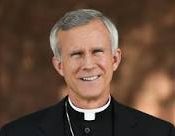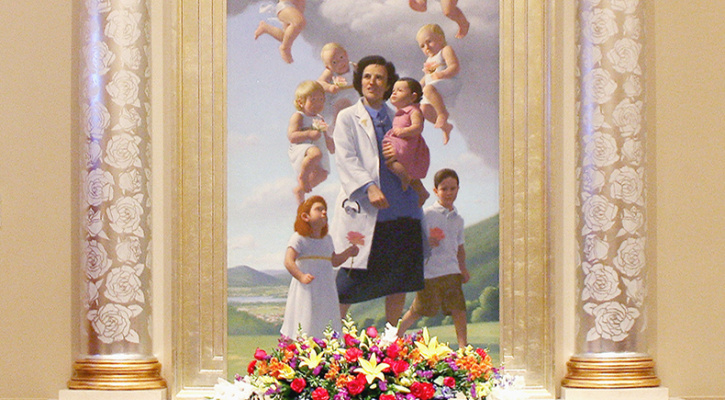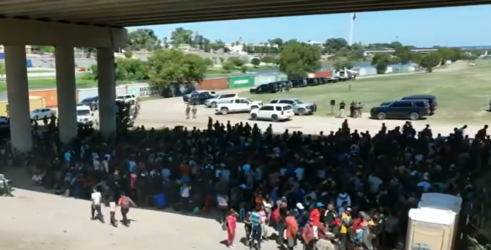Saint of the Day for January 16: St. Berard and Companions (d. Jan. 16, 1220)
January 16, 2020Cardinal Hummes: Pope’s Pan-Amazon Apostolic Exhortation to Be Published Soon, by Edward Pentin
January 16, 2020
By Most Reverend Bishop Joseph Strickland, The Wanderer, January 13, 2020
(Republished with permission of Mr. Joe Matt, The Wanderer)
 In our last column we considered what Catholic sacramental theology refers to as the Sacramental Economy. I quoted the Apostolic Exhortation on the Eucharist as the Source and Summit of the Life and Mission of the Church entitled The Sacrament of Charity (Sacramentum Caritatis). In paragraph sixteen, now Pope Emeritus Benedict XVI wrote:
In our last column we considered what Catholic sacramental theology refers to as the Sacramental Economy. I quoted the Apostolic Exhortation on the Eucharist as the Source and Summit of the Life and Mission of the Church entitled The Sacrament of Charity (Sacramentum Caritatis). In paragraph sixteen, now Pope Emeritus Benedict XVI wrote:
“The fact that the Church is the ‘universal sacrament of salvation’ shows how the sacramental economy ultimately determines the way that Christ, the one Savior, through the Spirit, reaches our lives in all their particularity. The Church receives and at the same time expresses what she herself is in the seven sacraments, thanks to which God’s grace concretely influences the lives of the faithful, so that their whole existence, redeemed by Christ, can become an act of worship pleasing to God.”
I explained that the Risen Lord Jesus Christ, through the sacraments, makes Himself and His saving grace, His Divine Life, available as a gift to be received by all who are prepared and properly disposed. We come to participate in Divine Life through receiving this grace. The Apostle Peter, in his second letter to the early churches, wrote:
“His divine power has granted to us all things that pertain to life and godliness, through the knowledge of him who called us to his own glory and excellence by which he has granted to us his precious and very great promises, so that through them you may become partakers of the divine nature” (2 Peter 1:3, 4(a)).
So, what are the effects of the seven sacraments on the recipient? How do they help us to progress in this participation in Divine Life? As mother and teacher, the Church uses a threefold division of the seven sacraments in order to help us understand.
As I have done in past columns, I will quote extensively from the Catechism of the Catholic Church. I do this because it is a wonderful, reliable, resource for all Catholics, and other Christians, who seek to more fully understand the teaching of the Catholic Church.
Pope St. John Paul II, in the first sentence of the introduction of his apostolic constitution Fidei Depositum (Guard the Deposit) officially promulgating the Catechism, wrote: “Guarding the Deposit of Faith is the mission which the Lord has entrusted to His Church and which she fulfills in every age.”
As a bishop, a successor of the apostles, it is a sacred duty for me to teach what the Church teaches and to defend it from those who seek to undermine it.
Let me repeat the helpful categories the Church offers to us in understanding the effects of the seven sacraments. There are the three Sacraments of Initiation: Baptism, Confirmation, and the Holy Eucharist. There are two sacraments of healing, Penance and the Anointing of the Sick. There are two sacraments at the service of communion and mission, Holy Orders and Christian Marriage.
Christian initiation is accomplished by the sacraments which establish the firm foundations of the Christian life. First, Baptism. The word itself means immersion. We are buried with Christ and raised up with Him when we pass through the Water of the Fount. We are born anew. And, we are freed from original sin.
Our first parents lost the grace of original holiness when they abused their freedom and chose against God’s loving plan. The Catechism of the Catholic Church, filled with copious references to the Bible, and Church councils, explains this in these words:
“Man, tempted by the devil, let his trust in his Creator die in his heart and, abusing his freedom, disobeyed God’s command. This is what man’s first sin consisted of. All subsequent sin would be disobedience toward God and lack of trust in his goodness.
“In that sin man preferred himself to God and by that very act scorned him. He chose himself over and against God, against the requirements of his creaturely status and therefore against his own good. Constituted in a state of holiness, man was destined to be fully ‘divinized’ by God in glory. Seduced by the devil, he wanted to ‘be like God,’ but ‘without God, before God, and not in accordance with God.’
“Scripture portrays the tragic consequences of this first disobedience. Adam and Eve immediately lose the grace of original holiness. They become afraid of the God of whom they have conceived a distorted image — that of a God jealous of his prerogatives.
“The harmony in which they had found themselves, thanks to original justice, is now destroyed: the control of the soul’s spiritual faculties over the body is shattered; the union of man and woman becomes subject to tensions, their relations henceforth marked by lust and domination. Harmony with creation is broken: visible creation has become alien and hostile to man. Because of man, creation is now subject ‘to its bondage to decay.’ Finally, the consequence explicitly foretold for this disobedience will come true: man will ‘return to the ground,’ for out of it he was taken. Death makes its entrance into human history.”
The effects of that original sin are passed to every man and woman unless they are freed of those effects through the saving waters of the “gateway” sacrament, the Sacrament of Baptism. The Catechism asks and answers a vital question:
“How did the sin of Adam become the sin of all his descendants? The whole human race is in Adam ‘as one body of one man.’ By this ‘unity of the human race’ all men are implicated in Adam’s sin, as all are implicated in Christ’s justice. Still, the transmission of original sin is a mystery that we cannot fully understand. But we do know by Revelation that Adam had received original holiness and justice not for himself alone, but for all human nature.”
Then, the Catechism explains how our first parents were tempted and what they did which caused the fall:
“By yielding to the tempter, Adam and Eve committed a personal sin, but this sin affected the human nature that they would then transmit in a fallen state. It is a sin which will be transmitted by propagation to all mankind, that is, by the transmission of a human nature deprived of original holiness and justice. And that is why original sin is called ‘sin’ only in an analogical sense: it is a sin ‘contracted’ and not ‘committed’ — a state and not an act.”
Next, the Catechism explains how the effects of that original sin are passed on, even though we did not commit it personally:
“Although it is proper to each individual, original sin does not have the character of a personal fault in any of Adam’s descendants. It is a deprivation of original holiness and justice, but human nature has not been totally corrupted: it is wounded in the natural powers proper to it, subject to ignorance, suffering and the dominion of death, and inclined to sin — an inclination to evil that is called ‘concupiscence.’ Baptism, by imparting the life of Christ’s grace, erases original sin and turns a man back towards God, but the consequences for nature, weakened and inclined to evil, persist in man and summon him to spiritual battle” (See CCC, nn. 397-406).
I encourage my readers to study these sections of the Catechism very closely. Read the biblical passages and council teachings which are cited therein. Pray and ask the Lord to open for you a deeper understanding of the faith. The Sacraments of Baptism, Confirmation, and Eucharist are all interrelated. All three are required for full Christian initiation into the Church, the Mystical Body of Christ.
The Christian is born anew by Baptism, strengthened and empowered by the Holy Spirit in Confirmation, and receives in the Eucharist the Body, Blood, Soul, and Divinity of Jesus Christ, the food of eternal life. Of the three, only the Holy Eucharist can be repeated. In fact, the Catechism is quite thorough about this. “The holy Eucharist completes Christian initiation. Those who have been raised to the dignity of the royal priesthood by Baptism and configured more deeply to Christ by Confirmation participate with the whole community in the Lord’s own sacrifice by means of the Eucharist” (CCC, n. 1322).
In the early Church these three sacraments were celebrated in the same rite by the bishop. During the first five centuries of the Roman Catholic Church (and still today in the Christian churches of the East), it was always the case that the sacraments of Christian initiation were celebrated in this sequence: Baptism, Confirmation, and Eucharist. And it was almost always the case that all three sacraments were celebrated together at the same time, even with infants.
In many dioceses today, including my own, the original order of these sacraments of initiation has been restored. The main reason for restoring the order of the sacraments (i.e., putting Confirmation before First Eucharist) is to emphasize that Eucharist is the sacrament of full communion.
It is explained in the Catechism:
“The Eucharist is the efficacious sign and sublime cause of that communion in the divine life and that unity of the People of God by which the Church is kept in being. It is the culmination both of God’s action sanctifying the world in Christ and of the worship men offer to Christ and through him to the Father in the Holy Spirit.”
“Finally, by the Eucharistic celebration we already unite ourselves with the heavenly liturgy and anticipate eternal life, when God will be all in all. In brief, the Eucharist is the sum and summary of our faith: ‘Our way of thinking is attuned to the Eucharist, and the Eucharist in turn confirms our way of thinking’” (CCC, nn. 1324-1327, citing, among other sources, the teaching of St. Irenaeus of Lyon, a second-century bishop).
In 2003 Pope St. John Paul II issued Ecclesia de Eucharist (The Church From the Eucharist). In the introduction he wrote: “The Church draws her life from the Eucharist. This truth does not simply express a daily experience of faith but recapitulates the heart of the mystery of the Church. In a variety of ways she joyfully experiences the constant fulfillment of the promise: ‘Lo, I am with you always, to the close of the age’ (Matt. 28:20), but in the Holy Eucharist, through the changing of bread and wine into the body and blood of the Lord, she rejoices in this presence with unique intensity.” The Pope continued: “The Second Vatican Council rightly proclaimed that the Eucharistic sacrifice is the source and summit of the Christian life. For the most holy Eucharist contains the Church’s entire spiritual wealth.”
The Church still draws her life from the Holy Eucharist. The Holy Eucharist, Vatican II tells us, is “the source and summit of the Christian life” (Lumen Gentium, n. 11; cf. Catechism of the Catholic Church, n. 1324). Given the centrality and primacy of this sacrament, a 2019 Pew Research study should be a serious warning sign for the bishops of the Catholic Church.
The survey indicated that “just one-third of U.S. Catholics (31 percent) say they believe that during Catholic Mass, the bread and wine actually become the body and blood of Jesus.” This is a serious failure which requires a serious response.
The teaching of Jesus Christ is clear. The Hebrew Scripture prefigured the Eucharist (see Exodus 12:1-20, 16:2-16). New Testament Scripture affirms the Real Presence (see Luke 24:13-35, John 6:22-71). Jesus tells the Twelve at the Last Supper, saying, “This is my body, which will be given for you; do this in memory of me.” And likewise, the cup after they had eaten, saying, “This cup is the new covenant in my blood, which will be shed for you” (Luke 22:14-20). The Apostle Paul affirmed the bread and wine offered at the Eucharistic Sacrifice become the Body and Blood of Jesus Christ (1 Cor. 11:23-29).
The apostles offered the Sacrifice of the Holy Mass and said the same words, “This is my body, which will be given for you; do this in memory of me.” And likewise, the cup after they had eaten, saying, “This cup is the new covenant in my blood, which will be shed for you.” The early Church Fathers believed in the Real Presence. For example, in his first lecture to the early catechumens Cyril of Alexandria explained:
“The bread and wine before the holy invocation are ordinary bread and wine, but after the invocation the bread becomes the Body of Christ and the wine the Blood of Christ.” In his fourth lecture Cyril asked the following question, “Christ Himself declared, speaking of the bread, ‘This is my Body.’ Who will dare then to hesitate in the future? And when He Himself asserts categorically ‘This is my blood,’ who will doubt it and say it is not His Blood?”
Jesus still tells His disciples “Amen, amen, I say to you, unless you eat the flesh of the Son of Man and drink His Blood, you do not have life within you.” To that, many of the disciples responded, “This saying is hard; who can accept it?”
“As a result of this, many [of] his disciples returned to their former way of life and no longer accompanied Him” (John 6: 22-71). Sadly, many Catholics “no longer accompany Him.”
The Glossary of the Catechism of the Catholic Church gives us an explanation of the term “Real Presence”: “The unique, true presence of Christ in the Eucharist under the species or appearances of bread and wine. The Church invites the faithful to deepen their faith in the real presence of Christ through adoration and communion at the Eucharistic liturgy, and through adoration outside its celebration” (nn. 1378-1379).
And, the paragraphs cited within the main body of the Catechism explain this fundamental doctrinal truth with references not only to the very words of Jesus and the New Testament passages, but with references to the early Church fathers and councils. See nn. 1373-1376.








